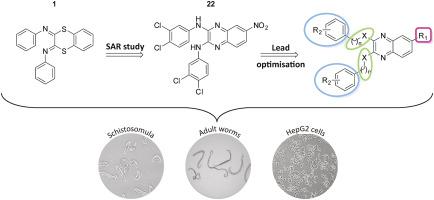European Journal of Medicinal Chemistry ( IF 6.0 ) Pub Date : 2021-09-10 , DOI: 10.1016/j.ejmech.2021.113823 Gilda Padalino 1 , Nelly El-Sakkary 2 , Lawrence J Liu 2 , Chenxi Liu 2 , Danielle S G Harte 3 , Rachel E Barnes 3 , Edward Sayers 4 , Josephine Forde-Thomas 1 , Helen Whiteland 1 , Marcella Bassetto 5 , Salvatore Ferla 3 , George Johnson 3 , Arwyn T Jones 4 , Conor R Caffrey 2 , Iain Chalmers 1 , Andrea Brancale 4 , Karl F Hoffmann 1

|
Schistosomiasis is a neglected disease of poverty that is caused by infection with blood fluke species contained within the genus Schistosoma. For the last 40 years, control of schistosomiasis in endemic regions has predominantly been facilitated by administration of a single drug, praziquantel. Due to limitations in this mono-chemotherapeutic approach for sustaining schistosomiasis control into the future, alternative anti-schistosomal compounds are increasingly being sought by the drug discovery community. Herein, we describe a multi-pronged, integrated strategy that led to the identification and further exploration of the quinoxaline core as a promising anti-schistosomal scaffold.
Firstly, phenotypic screening of commercially available small molecules resulted in the identification of a moderately active hit compound against Schistosoma mansoni (1, EC50 = 4.59 μM on schistosomula). Secondary exploration of the chemical space around compound 1 led to the identification of a quinoxaline-core containing, non-genotoxic lead (compound 22). Compound 22 demonstrated substantially improved activities on both intra-mammalian (EC50 = 0.44 μM, 0.20 μM and 84.7 nM, on schistosomula, juvenile and adult worms, respectively) and intra-molluscan (sporocyst) S. mansoni lifecycle stages. Further medicinal chemistry optimisation of compound 22, resulting in the generation of 20 additional analogues, improved our understanding of the structure-activity relationship and resulted in considerable improvements in both anti-schistosome potency and selectivity (e.g. compound 30; EC50 = 2.59 nM on adult worms; selectivity index compared to the HepG2 cell line = 348). Some derivatives of compound 22 (e.g. 31 and 33) also demonstrated significant activity against the two other medically important species, Schistosoma haematobium and Schistosoma japonicum. Further optimisation of this class of anti-schistosomal is ongoing and could lead to the development of an urgently needed alternative to praziquantel for assisting in schistosomiasis elimination strategies.
中文翻译:

含喹喔啉化合物的抗血吸虫活性:从命中识别到先导优化
血吸虫病是一种被忽视的贫困疾病,由血吸虫属中的血吸虫感染引起。在过去的 40 年中,流行地区的血吸虫病控制主要通过使用单一药物吡喹酮来促进。由于这种单一化疗方法在未来维持血吸虫病控制方面的局限性,药物发现界越来越多地寻求替代的抗血吸虫化合物。在此,我们描述了一种多管齐下的综合策略,该策略导致了喹喔啉核心作为一种有前途的抗血吸虫支架的鉴定和进一步探索。
首先,对市售小分子的表型筛选导致鉴定出一种针对曼氏血吸虫的中等活性的命中化合物( 1,EC 50 = 4.59 μM,对血吸虫)。对化合物 1 周围化学空间的二次探索导致鉴定出含有喹喔啉核心的非遗传毒性铅(化合物 22)。化合物 22 对哺乳动物体内(EC 50 = 0.44 μM、0.20 μM 和 84.7 nM,分别对血吸虫、幼虫和成虫)和软体动物体内(孢子囊)S. mansoni表现出显着改善的活性生命周期阶段。化合物 22 的进一步药物化学优化,产生了 20 个额外的类似物,提高了我们对构效关系的理解,并导致抗血吸虫效力和选择性的显着改善(例如化合物 30;EC 50 = 2.59 nM成虫;与 HepG2 细胞系相比的选择性指数 = 348)。化合物 22 的一些衍生物(例如 31 和 33)也表现出对其他两种医学上重要的物种血吸虫和日本血吸虫的显着活性. 此类抗血吸虫药物的进一步优化正在进行中,并可能导致开发一种急需的吡喹酮替代品,以协助消除血吸虫病的策略。











































 京公网安备 11010802027423号
京公网安备 11010802027423号